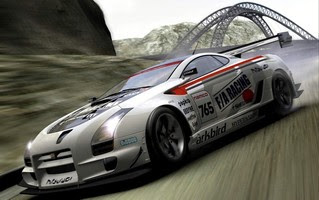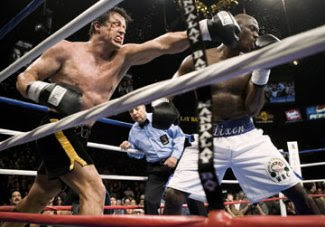In the second of The Shed's ongoing series of fashionably late 360 reviews comes Gears Of War, that already much discussed, 3 million plus selling shooter.
 ^ Take That's second reunion in 2060 saw the group try out a dark new look.
^ Take That's second reunion in 2060 saw the group try out a dark new look.
Landon isn't the biggest fan of shooters. Wolfenstein 3D was the the last first-person title he really and truly loved. He danced with Unreal, flirted with Kingpin, but for some reason they've never been his thing. It wasn't until Killzone and Black that his sceptic anti-stance was softened and his rapid-fire love rekindled. With Gears, he's a fan once more.
For one thing, Gears is third-person. In third-person you get to take in your character - and when your character is as loveably rough as Marcus Fenix, that's a big positive. Secondly, the tactical mechanics of Gears are unique. Shooters have used cover systems before, but nothing as intuitive and joyful as this. All you need is one button to get you out of immediate danger. With this button you can dive, roll, sprint low to the ground and lunge for cover against scenery. Walls, pillars, sofas, antique chests of drawers - the lavishly detailed environments are there to be used as well as gawked at. Once stuck to cover you can duck out and shoot, blind-fire, spin to other nearby cover, jump over or push forward to gain ground. It'll take about half an hour to get to grips with and it'll take sustained sessions to master, but soon you'll move like a military bad-ass.
It's this emphasis on tactics and team play that makes Gears so different. The campaign can be battled through alone or split-screen with a mate (playing as Dom, Marcus' bestest pal). In addition you'll be backed up by other CPU soldiers - these guys aren't fools, occasionally they might even save your ass, which is much needed when you're up against intelligent enemies. But if you're playing through with a friend, they'll be the team member you really rely on. Locust will flank you, rush you and flush you out into the open. Communication becomes key to progression. Who will take out the sniper? Who will push ahead for a pre-emptive close up assault? Shit, it's even fun to argue over who gets the next grenade pickup.
Ever since Landon first played a computer game, he's always seen games as a social experience. Ultimately, games will always be more rewarding with two players working side by side to best the bad guys. Streets Of Rage, Two Crude Dudes, Probotector. It's been a long, long wait for the next great co-op adventure. It's here.
The campaign mode is immersive and whilst the plot is light in terms of any concrete details, under the surface action the story has some weight to it, at least enough to keep things steaming from one local to the next. And it's the level design that is perhaps the most brilliant aspect of Gears. Varied, intricate and never less than breathtaking to look at. You'll shoot your way through bombed-out streets, dark gothic buildings, factories, caves, gardens, mansions...there's even a section that takes place on a mine cart. Amazingly, it never feels like the art designers are throwing an ornate kitchen sink at your head. It's always in service of the story or to heighten the action - the war torn planet of Sera is realistic, tactile - the years of its history convincing. Gears is far from a no-brainer, either. Certain levels bring a horror element to the table, requiring you to tread carefully and observe your surroundings or risk a sudden death. It's this varied pace that makes the fire-fights so exhilarating when they arrive, Locust Horde screaming.

Any good shooter needs to bring the heavy artillery and Gears delivers, but it's refreshing to see intelligent design here too. It isn't one of these mushroom cloud laying muthafuckers where guns are over abundant, the player as God raining down the pain. Only being able to carry a simple arsenal, Gears players quickly become astute at selecting what's best for the given situation. Every weapon has its uses too, even ones that seem unwieldy at first can become life savers when dishing the hurt to certain nasties. 'Hardcore' and 'Insane' modes will last you a long while and will serve to sharpen your skills for multiplayer. With it's emphasis on teamwork, it's no surprise Gears has overtaken Halo 2 as the online favourite. Although Landon died within a minute of entering a match, he had to chuckle at himself getting split in two with a chainsaw. It's painful fun and another excuse to get together with more of your friends online, and perhaps frag some new ones too. Gears Of War is the new Myspace, yah yah.
Gears Of War is rightly the 360 poster boy because it has given the console something no other next-gen machine can yet lay claim to - a bona-fide, across the board landmark game. It's worth buying the damn console for. It's a title every gamer needs to play. It's the benchmark for what a killer app can achieve. Gears has entered the gaming pantheon and Epic are the extra kings of the gaming community right now. And yet, Landon wants to be honest with you - he can't stand to even look at the case anymore. He's decided to trade Gears in. He's going to trade it for the collector's version in the shiny black tin. He wants the artwork, he wants his little piece of history. Call him sad. Call him a geek. He wants that fucking tin.
ShedLove: 10/10
 Resistance: Fall Of Man (Sony) – Blast ugly scum and take back Britain’s rubble strewn streets, then play this to wind down when you’ve finished. An array of exotic weapons like rifles that shoot through walls and round corners as well as
Resistance: Fall Of Man (Sony) – Blast ugly scum and take back Britain’s rubble strewn streets, then play this to wind down when you’ve finished. An array of exotic weapons like rifles that shoot through walls and round corners as well as
 especially) raving on about this whilst we’re unable to see what all the fuss is about. Well, come March 23rd, we’ll get to find out. Including add-on pack Knights of the Nine as standard; we’re shining our helmets and polishing our broadswords in anticipation. Our lives are more than dull enough to be consumed by such a beautifully polished RPG, which is why we're seriously looking forward to this. (Landon isn't, and would like to state for the record that he hates RPGs of all types).
especially) raving on about this whilst we’re unable to see what all the fuss is about. Well, come March 23rd, we’ll get to find out. Including add-on pack Knights of the Nine as standard; we’re shining our helmets and polishing our broadswords in anticipation. Our lives are more than dull enough to be consumed by such a beautifully polished RPG, which is why we're seriously looking forward to this. (Landon isn't, and would like to state for the record that he hates RPGs of all types).
 er than ever. Visually smooth and crisp, there’s no doubt that the unique arcade-handling will remain intact meaning that Ridge will always be that irresistible, creamy middle ground between Gran Turismo’s stuffy simulation and Burnout’s extreme arse-puckering speed and pyrotechnics. For that, we will always reserve a special place in our gaming heart for Ridge Racer.
er than ever. Visually smooth and crisp, there’s no doubt that the unique arcade-handling will remain intact meaning that Ridge will always be that irresistible, creamy middle ground between Gran Turismo’s stuffy simulation and Burnout’s extreme arse-puckering speed and pyrotechnics. For that, we will always reserve a special place in our gaming heart for Ridge Racer.










